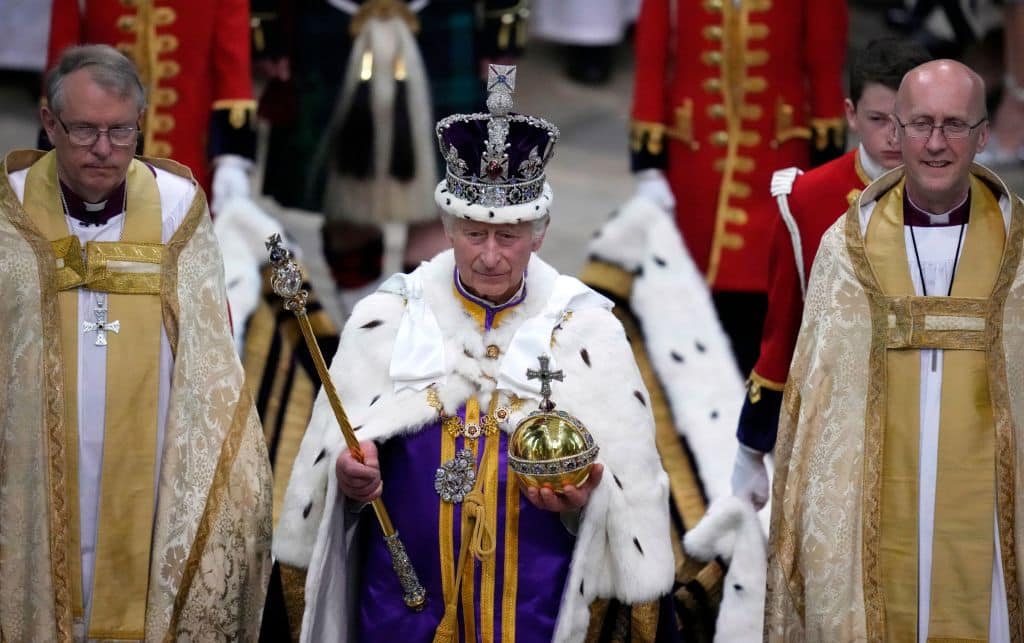So: the Coronation. Not quite everything that one might have liked in an ideal world – obviously not nearly enough ermine – but certainly not as disappointing or lacklustre as might have been feared in some quarters. I think I may now be in love with HRH the Princess of Wales and possibly also the redoubtable and Rt Hon Penny Mordaunt MP. St Jude, patron saint of hopeless causes, pray for this poor son of thine.
Three cheers for the various heraldic Kings of Arms for turning out in full fig, complete with cream breeches and acanthus-leaf crowns. I will never understand the aversion to hats, and the same applies to birettas. If one’s already got a funny costume, the headgear really isn’t going to make much of a difference. When Our Lord hands round the crowns in heaven, who’s going to say no?
Unlike Maltravers Herald Extraordinary – our old friend Dr John Martin Robinson, who writes elsewhere in this issue about his front-row view – I watched the pageant unfold on the television with friends, a Labrador retriever and two small inquisitive children. A stream of questions from the last constituency had to be fielded as best they could be, peppered with injunctions for silence at certain solemn points.
At lighter moments we played our own game of spot-the-chum: “oh, look – there’s so-and-so”. Alas, we failed to see our hostess’s uncle, who happens also to be a Knight of the Garter. The last time I saw him in the flesh I was crossing Whitehall, and he nearly knocked me down on his bicycle – whizzing from his club on St James’s, no doubt, to a division in the House of Lords.
Speaking of Knights of the Garter, I think that on balance I would have preferred four of them carrying a cloth-of-gold canopy over St Edward’s Chair to soldiers with the specially-commissioned embroidered anointing screen; but the responsible guardsmen did a splendid job and it was touching to see them with eyes downcast at such a sacred moment – and no peeking.
Any grumbling fell away, however, when the King was divested in front of the High Altar and the imagery of the next 40 minutes turned us all into time travellers. Without the ermine robe or the purple and gold-edged surcoat and wearing only a white undershirt he looked like the first English king of his name on the scaffold just a few hundred yards away at the Banqueting House – not exactly a comfortable thought.
But then the orchestra struck up with the familiar introduction to Handel’s most famous coronation anthem of all, and suddenly we were in deep into the Old Testament. The Archbishop of Canterbury and the Dean of Westminster moved forward with the ampulla full of oil blessed at Jerusalem and the great golden spoon, as the massed choirs thundered in: “Zadok the Priest and Nathan the Prophet anointed Solomon King.”
Next came the donning of the golden garments to Greek chant at His Majesty’s own request. Having been in pre-Temple Israel suddenly we were on the shores of the Bosphorus, in Hagia Sophia, perhaps – one of the greatest churches of the world, let it not be forgotten – while the King put on the colobium sindonis, supertunica, girdle, stole and mantle: mystic vestments, part kingly and part priestly and weighty in both a literal and metaphorical sense.
I wasn’t expecting to be so affected by the sight of such an evidently ancient rite. What is all the more striking is that while the Church of England was flirting dangerously with Luther, Calvin and the rest in the mid-16th century, it dared not touch the Liber Regalis in which the coronation rite was contained. Most of the sacramental elements it retains were ignominiously banished from the life of the English Church – but not, it seems, for kings.
This takes on immense significance when one remembers that Leo XIII’s rejection of Anglican orders in 1897 was at least in part based on the argument that ordinations in the Church of England were deficient both in intention and in rite. Not that long ago, two Anglican exchange students at a certain seminary in Rome were affectionately and respectively known as “Null” and “Void”.
The world looked on, then, as an Anglican primate anointed a monarch with oil hallowed by an Orthodox patriarch, before crowning him using a recognisably Catholic rite that contains many elements that date back to before the Great Schism and so belong to the Church when she was whole and undivided. It was all a great amount to take in and to process – exhilarating, even, for those with eyes to see.
The best mash-up of all, however, came much earlier on, when the King knelt down and swore the Oath – “I am a faithful Protestant” – surrounded on all sides by Church of England prelates clad in copes of white damask which looked strangely familiar. It is now widely known that they were on loan, deliciously, from Westminster Cathedral. No doubt they were taken down Victoria Street on His Eminence’s orders by a sacristan with a twinkle in his eye.



